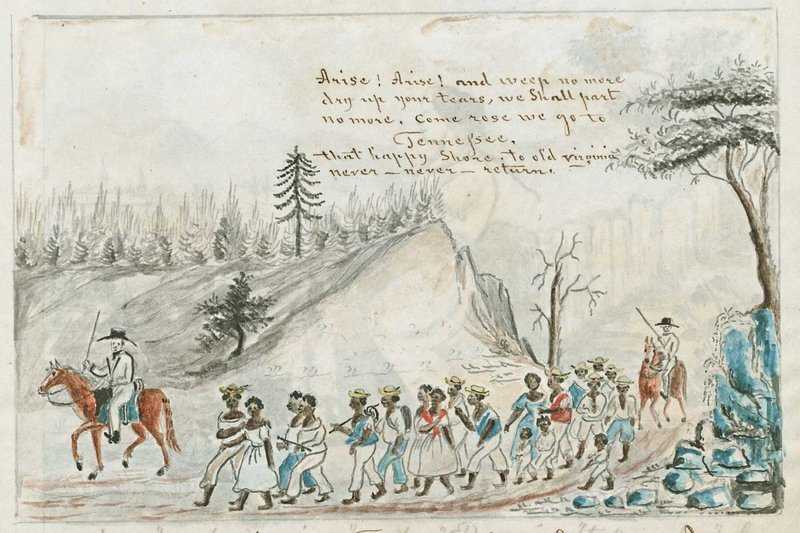Chapter 2
Codifying Slavery
Leaders of the young nation felt that God granted them a manifest destiny to expand landownership, capitalism, and slavery from sea to shining sea. They achieved their goals through far-reaching and impactful legislation. Slavery rested at the heart of such legislation that laid the foundation for generations that followed. Indigenous people faced forced removal from their homelands while yeoman white farmers and poor whites competed with the planter elite to gain access to a piece of the American pie. Meanwhile African Americans, free and enslaved, fought to survive and pushed the meaning, application, and manifestation of freedom.
The Revolution’s language of liberty influenced government policy. With the Northwest Ordinance, the new nation limited slavery, banning it in territories above the Ohio River (present-day Ohio, Indiana, and Illinois). This act created the nation’s first federally guaranteed free territory. The region became home to many free Black communities.
The expansion of the cotton empire cemented slavery in American society and the economy. Each new territory raised the stakes: would it be slave or free? African Americans responded by enacting new visions of American freedom. Year by year, state by state, territory by territory, African Americans used the press, public protest, and movement to insist that slavery come to an end. This combination of words and actions left a mark on the Constitution and on the practice of political participation, deepening and enriching liberty for all.
The New Nation
The United States almost doubled in size after its victory in the American Revolution, triggering the mass movement of peoples, voluntarily and by force. To open land for settlement, the United States removed Native people by the thousands. United States citizens poured in, pushing tens of thousands of enslaved African Americans west to clear and cultivate rich farmland. The result was an economic boom based on human displacement.
The United States, 1787
The Louisiana Purchase: Expanding Slavery
The Louisiana Treaty, 1803
The United States doubled in size when it acquired the Louisiana Territory from the French in 1803 for $15,000,000. France sold the territory to concentrate its forces in the Caribbean after the Haitian Revolution, the world’s largest and most successful slave rebellion. By 1810, the Louisiana Purchase had enabled the United States to dominate the world market in cotton by exporting over 93 million pounds annually produced through the increasingly violent enforcement of slave labor.
The Louisiana Purchase opened the vast Mississippi River Valley to the American trade in cotton, sugar, midwestern farm products, and enslaved human beings. All these goods poured through New Orleans, which became one of the world’s busiest ports. Investors from London, Hamburg, Amsterdam, Paris, Philadelphia, Boston, and New York profited from the lucrative trade in enslaved human beings as well as the immense wealth produced by their labor.

The inhabitants of the ceded territory shall be incorporated in the Union of the United States and admitted [with] . . . rights, advantages and immunities of citizens.
Louisiana Purchase, 1803
Deslondes’s Rebellion: Freedom or Death
Louisiana Gazette and New Orleans Daily Advertiser, January 10, 1811
On January 8, 1811, Charles Deslondes led hundreds of armed enslaved African Americans along the banks of the Mississippi River in a march towards New Orleans. Among his comrades were men and women who had participated in the Haitian Revolution, a successful slave rebellion. News of the rebellion traveled quickly across the African Diaspora, further inspiring enslaved people across the Americas to take up arms and, against crushing odds, march towards freedom or death.

Several of our fellow citizens have been massacred, some dwelling houses burnt and others pillaged.
Louisiana Gazette and New Orleans Daily Advertiser, 1811
The Louisiana Purchase, 1803
The Abolition of the International Slave Trade, 1807: Limiting Slavery
The Abolition of the International Slave Trade, 1807
Antislavery advocates anxiously waited for New Year’s Day, 1808, when the federal law abolishing the international slave trade went into effect. But even after the law went into effect, well-financed merchant fleets operating primarily from New York and Rhode Island illegally traded people to the Americas. If enslavers were caught, their cargoes of enslaved people, still seen as commodities, were impounded as contraband goods and sold. In spite of the law, the domestic slave trade within the nation remained legal.
The closing of the Transatlantic Slave Trade changed Americans' relationship with the Caribbean. Deeply invested in the slave trade from Africa, American slave merchants moved their businesses to Cuba to maintain their profits. They belonged to a larger plantation enterprise that cut across national borders.

Be it enacted . . . [that] it shall not be lawful to import or bring into the United States . . . any negro, mulatto, or person of colour, with intent to hold, sell, or dispose of [them] . . . as a slave.
An Act to Prohibit the Importation of Slaves, 1807
Absalom Jones’s Thanksgiving Sermon: Remember this Day
Absalom Jones’s Thanksgiving Sermon, 1808
In Black churches across the country, ministers like Rev. Absalom Jones of St. Thomas’s African Episcopal Church in Philadelphia celebrated the closing of the international slave trade on January 1, 1808. Recognizing a partial victory in the fight against slavery, he called for remembrance of that day. People listened and acted. Each year, African Americans gathered to memorialize this moment with public pronouncements and to advocate for the abolition of slavery. This commemoration, and others like it, played a vital role in expanding democracy for all Americans.

Let the first of January, the day of the abolition of the slave trade . . . be set apart in every year, as a day of publick thanksgiving. . . . Let the history of the sufferings . . . and of . . . deliverance . . . descend . . . to the remotest generations.
Absalom Jones, January 1, 1808
Abolition of the International Slave Trade, 1808
The War of 1812
Charles Ball and the Chesapeake Bay Flotilla
The War of 1812, fought between the United States and England, centered on economic and trade disputes, including slavery. Similar to their actions during the Revolutionary War, African Americans aligned themselves with whichever side promised their freedom. British forces in the Chesapeake provided an opportunity for thousands of enslaved to self-liberate; around 600 freemen also enlisted in the Colonial Marines. Britain’s promise of freedom gave rise to revolt from the enslaved who assisted the British in battle against Americans, including enslavers. Other enslaved men joined the American forces as soldiers and sailors, hoping for equality and freedom that was rarely awarded. However, it became clear that military service did not provide access to freedom or a firm democracy. Many enslaved veterans, including Charles Ball and Ned Simmons, were returned to their enslavers.
